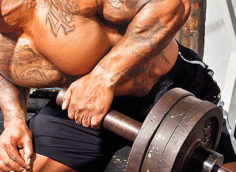The strict barbell press is a fundamental movement for building muscle and strength, but only when you do it with good form. Often, when a person thinks he has a shoulder mobility or strength problem with this lift, it's actually a core problem, NOT a shoulder issue.
Most people are aware of their more dominant side – one side feeling stronger than the other. Obviously, when you want to press overhead with both arms, you want both sides working together at the same time to give you maximum gains.
The Issue
The problem with barbells is that you could be pressing sideways or pressing more with one side than the other. The signs may not be noticeable to the untrained eye, unless you're going heavy.
So, should you just use lighter weights? Well, you can still have bad technique with light weights. In fact, with higher reps and lighter weight over a longer period of time, you're even more likely to be ingraining a bad movement pattern.
Imagine your core as a house of playing cards. If you have one card slightly unstable the entire thing will crumble. If you have the slightest weakness on one side you'll not only crumble, you'll hurt something.
Ask yourself this: Can you do the same movement to the same level on both sides? Yes? Then keep at it. No? Sort that out first and then get back to training. Here's one great way to do it.
The Single Arm and Single Leg Press
Standing on one leg with your knee raised automatically forces your glute to work on the supporting leg; the raised leg switches on your core. If you can't stand on one leg for an extended period of time, that's something you really should work on first.
Having the strength and balance to do something like that should never be a big deal to someone who enjoys weight training. In a one-legged position we automatically create an environment for teaching the body how to be braced when pressing.
Next complete three reps of each variation:
- Left arm, left leg
- Left arm, right leg
- Right arm, left leg
- Right arm, right leg
The weight needs to be challenging enough that you have to work to stay stabilized, but not so heavy that you risk falling over or hurting yourself. No 1-rep max attempts with this one!
Anyone with shoulder issues or weaknesses will usually find that they fail on one or two of these variations. Simply working on this movement and becoming better at it will assist in bringing you back into balance.
Bear in mind that this is a stability drill, not a strength pursuit. If one set is effortless and another set looks ugly as hell but you still "get the weight," that's still a fail.
Using this as a warm-up is a great way to prime your body for most types of training. When you find the right weight, do 3-5 sets, then implement the same core intensity into your pressing movements on both legs.
This is something you can revisit as often as you'd like. You can always get better at bracing!






